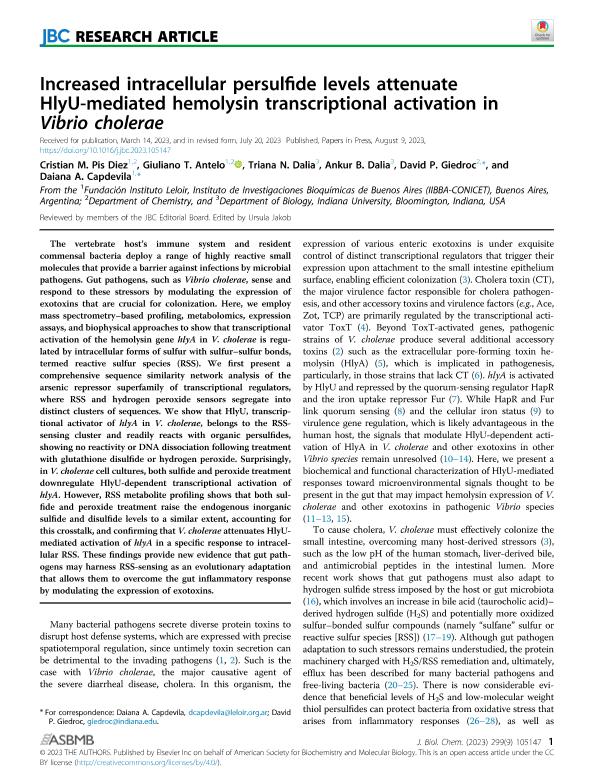Mostrar el registro sencillo del ítem
dc.contributor.author
Pis Diez, Cristian Manuel

dc.contributor.author
Antelo, Giuliano Tomás

dc.contributor.author
Dalia, Triana N.
dc.contributor.author
Dalia, Ankur B.
dc.contributor.author
Giedroc, David Peter

dc.contributor.author
Capdevila, Daiana Andrea

dc.date.available
2024-02-29T12:02:51Z
dc.date.issued
2023-09
dc.identifier.citation
Pis Diez, Cristian Manuel; Antelo, Giuliano Tomás; Dalia, Triana N.; Dalia, Ankur B.; Giedroc, David Peter; et al.; Increased intracellular persulfide levels attenuate HlyU-mediated hemolysin transcriptional activation in Vibrio cholerae; American Society for Biochemistry and Molecular Biology; Journal of Biological Chemistry (online); 299; 9; 9-2023; 1-17
dc.identifier.issn
0021-9258
dc.identifier.uri
http://hdl.handle.net/11336/228906
dc.description.abstract
The vertebrate host's immune system and resident commensal bacteria deploy a range of highly reactive small molecules that provide a barrier against infections by microbial pathogens. Gut pathogens, such as Vibrio cholerae, sense and respond to these stressors by modulating the expression of exotoxins that are crucial for colonization. Here, we employ mass spectrometry–based profiling, metabolomics, expression assays, and biophysical approaches to show that transcriptional activation of the hemolysin gene hlyA in V. cholerae is regulated by intracellular forms of sulfur with sulfur–sulfur bonds, termed reactive sulfur species (RSS). We first present a comprehensive sequence similarity network analysis of the arsenic repressor superfamily of transcriptional regulators, where RSS and hydrogen peroxide sensors segregate into distinct clusters of sequences. We show that HlyU, transcriptional activator of hlyA in V. cholerae, belongs to the RSS-sensing cluster and readily reacts with organic persulfides, showing no reactivity or DNA dissociation following treatment with glutathione disulfide or hydrogen peroxide. Surprisingly, in V. cholerae cell cultures, both sulfide and peroxide treatment downregulate HlyU-dependent transcriptional activation of hlyA. However, RSS metabolite profiling shows that both sulfide and peroxide treatment raise the endogenous inorganic sulfide and disulfide levels to a similar extent, accounting for this crosstalk, and confirming that V. cholerae attenuates HlyU-mediated activation of hlyA in a specific response to intracellular RSS. These findings provide new evidence that gut pathogens may harness RSS-sensing as an evolutionary adaptation that allows them to overcome the gut inflammatory response by modulating the expression of exotoxins.
dc.format
application/pdf
dc.language.iso
eng
dc.publisher
American Society for Biochemistry and Molecular Biology

dc.rights
info:eu-repo/semantics/openAccess
dc.rights.uri
https://creativecommons.org/licenses/by/2.5/ar/
dc.subject
BACTERIAL PATHOGENESIS
dc.subject
BACTERIAL TOXIN
dc.subject
BACTERIAL TRANSCRIPTION
dc.subject
HOMOCYSTEINE
dc.subject
HOST–PATHOGEN INTERACTION
dc.subject
SULFUR
dc.subject
THIOL
dc.subject
TRANSCRIPTION REGULATION
dc.subject
VIBRIO CHOLERAE
dc.subject.classification
Bioquímica y Biología Molecular

dc.subject.classification
Ciencias Biológicas

dc.subject.classification
CIENCIAS NATURALES Y EXACTAS

dc.subject.classification
Biofísica

dc.subject.classification
Ciencias Biológicas

dc.subject.classification
CIENCIAS NATURALES Y EXACTAS

dc.title
Increased intracellular persulfide levels attenuate HlyU-mediated hemolysin transcriptional activation in Vibrio cholerae
dc.type
info:eu-repo/semantics/article
dc.type
info:ar-repo/semantics/artículo
dc.type
info:eu-repo/semantics/publishedVersion
dc.date.updated
2024-02-28T09:54:25Z
dc.journal.volume
299
dc.journal.number
9
dc.journal.pagination
1-17
dc.journal.pais
Estados Unidos

dc.journal.ciudad
Bethesda
dc.description.fil
Fil: Pis Diez, Cristian Manuel. Consejo Nacional de Investigaciones Científicas y Técnicas. Oficina de Coordinación Administrativa Parque Centenario. Instituto de Investigaciones Bioquímicas de Buenos Aires. Fundación Instituto Leloir. Instituto de Investigaciones Bioquímicas de Buenos Aires; Argentina. Indiana University; Estados Unidos
dc.description.fil
Fil: Antelo, Giuliano Tomás. Consejo Nacional de Investigaciones Científicas y Técnicas. Oficina de Coordinación Administrativa Parque Centenario. Instituto de Investigaciones Bioquímicas de Buenos Aires. Fundación Instituto Leloir. Instituto de Investigaciones Bioquímicas de Buenos Aires; Argentina. Indiana University; Estados Unidos
dc.description.fil
Fil: Dalia, Triana N.. Indiana University; Estados Unidos
dc.description.fil
Fil: Dalia, Ankur B.. Indiana University; Estados Unidos
dc.description.fil
Fil: Giedroc, David Peter. Indiana University; Estados Unidos
dc.description.fil
Fil: Capdevila, Daiana Andrea. Consejo Nacional de Investigaciones Científicas y Técnicas. Oficina de Coordinación Administrativa Parque Centenario. Instituto de Investigaciones Bioquímicas de Buenos Aires. Fundación Instituto Leloir. Instituto de Investigaciones Bioquímicas de Buenos Aires; Argentina
dc.journal.title
Journal of Biological Chemistry (online)

dc.relation.alternativeid
info:eu-repo/semantics/altIdentifier/url/https://www.sciencedirect.com/science/article/pii/S0021925823021750
dc.relation.alternativeid
info:eu-repo/semantics/altIdentifier/doi/http://dx.doi.org/10.1016/j.jbc.2023.105147
Archivos asociados
